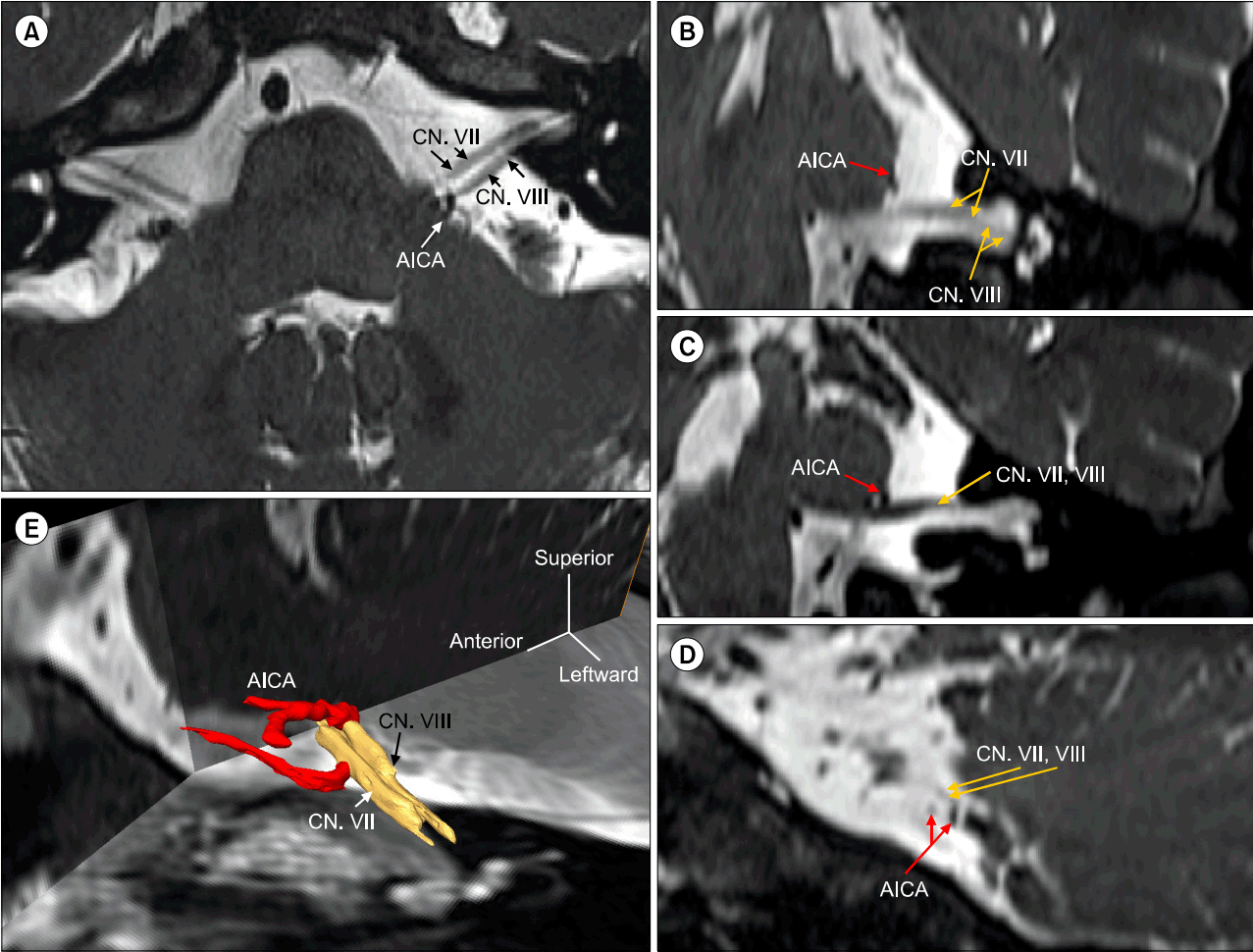혈관압박에 의해 동시에 발생한 전정발작과 반얼굴연축
Vestibular Paroxysmia and Hemifacial Spasm by Vascular Compression
Article information
Trans Abstract
Vestibular Paroxysmia and facial spasm may be caused by vascular compression of the vestibular and facial root entry zone. We report a case of paroxysmal nystagmus accompanied by facial spasm and which is well visualized by three-dimensional reconstruction images. The 3-dimensional reconstruction image supports the view that vestibular paroxysmia may occur with hemifacial spasm simultaneously due to vascular compression.
INTRODUCTION
Vestibular paroxysmia or hemifacial spasm can occurs due to vascular compression upon each seventh or eighth nerve independently [1,2]. And those presentation may happen synchronously [3]. We report a case of the paroxysmal nystagmus accompanied by hemifacial spasm which are well visualized by three dimensional (3D) reconstruction images and 3D animation.
CASE REPORT
A 55-year-old woman was referred for recurrent attacks of spontaneous vertigo lasting several seconds. She reported no auditory symptoms including tinnitus. She had no medical history except hypertension. She felt dizziness 10 years ago. Dizziness deteriorated deeply and accompanied involuntary facial movement a year ago. Neurologic examination showed right beating, torsional nystagmus and hemifacial spasm on the left side, and these nystagmus and facial spasm occurred synchronously. Brain magnetic resonance imaging revealed anterior inferior cerebellar artery (AICA) was in contact with the roots of facial and vestibular nerves (Fig. 1A–C). Three dimensional reconstruction was acquired by axial, coronal and saggital images and they showed that the AICA surrounded the two nerves very closely (Fig. 1D) by forming an arterial loop (Suppl Video S1). The symptoms were resolved after treatment of carbamazepine 200 mg per day.

Brain magnetic resonance imaging and 3-dimensional reconstruction image of the patient. (A) The T2 axial image reveals the anterior inferior cerebellar artery (AICA) crosses the root of the seventh and eighth cranial nerves. (B) The T2 coronal images show the AICA comes out toward the seventh cranial nerve and (C) is in contact with the root of the cranial nerves. (D) The T2 saggital image demonstrates the cross section of the nerves and the AICA. (E) The three dimensional reconstruction image shows the AICA goes back and forward by looping around the seventh and eighth cranial nerves. CN, cranial nerve.
DISCUSSION
The images of this case presented the arterial compression of the roots of seventh and eighth cranial nerves. Especially, three dimensional reconstruction image and video would aid in understanding and recognizing the mechanism of vestibular paroxysmia accompanied by hemifacial spasm by visualizing the course of the artery and nerves. Anatomically, the course of a cranial nerve is divided into a peripheral and a central part. The area where the nerve is myelinated by Schwann cells is defined as root-entry-zone (REZ). The REZ is histologically myelinated by oligodendroglia. Within the REZ, the susceptibility for developing a neurovascular compressing syndrome seems to be highest [4]. To the best our knowledge, our case will be the first report of the vestibular paroxysmia using the 3-dimensional animation.
Notes
No potential conflict of interest relevant to this article was reported.
Supplementary Material
Suppl Video S1.
The video demonstrated the 90 degree rotatory view of the structures around the 8th nerve entry zone and revealed that the anterior inferior cerebellar artery surro.
Supplemental data can be found at: (https://doi.org/10.21790/rvs.2017.16.4.171).